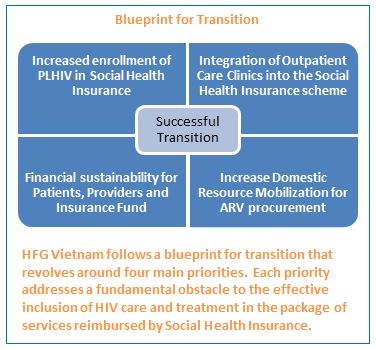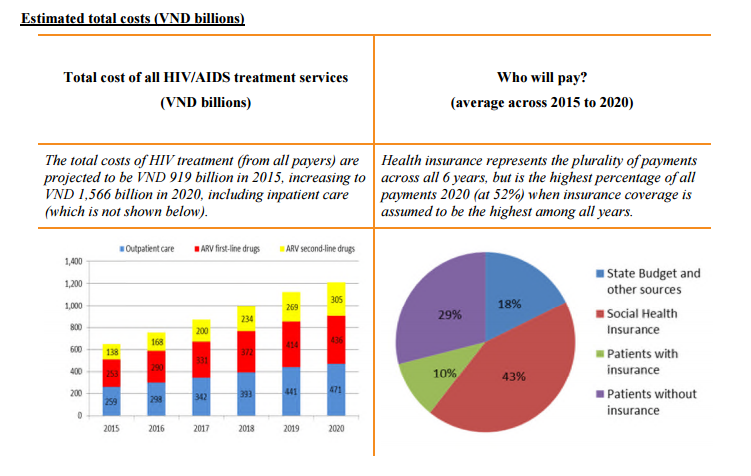In Vietnam, Quantifying Needs and Domestic Resources for HIV and AIDS Treatment
Categories: Announcements, Where We Work
In Vietnam, an estimated 250,000 people are living with HIV (PLHIV), and about 100,000 are on antiretroviral (ARV) treatment, according to the Ministry of Health. With donor funding expected to decline, it is critical for the government to identify viable solutions for sustaining HIV and AIDS prevention, care, and treatment services. HFG is supporting the country’s health financing activities, which includes identifying viable solutions for sustaining HIV and AIDS prevention, care, and treatment services. As a lower-middle income economy, Vietnam has recently become the recipient of funding from USAID’s Sustainable Financing Initiative (SFI), a PEPFAR-funded innovative mechanism to promote Domestic Resource Mobilization (DRM) in countries where external funding for HIV/AIDS is projected to incrementally diminish over time. With SFI and USAID/Vietnam support, HFG’s team in Vietnam is working with the Ministry of Health and other stakeholders to build health financing capacity to analyze domestic resource mobilization options and to leverage the Social Health Insurance (SHI) system to progressively increase domestic funding for HIV.
At the recent National Scientific Conference on HIV and AIDS in Hanoi, Vietnam, HFG’s Naz Todini presented the key results from a new study, Model to Estimate Health Insurance Liability for Treatment of HIV/AIDS in Vietnam (2015–2020). Conducted in partnership with the Vietnam Authority of AIDS Control (VAAC), the study forecasts the amounts of funding needed from SHI and other sources for HIV/AIDS treatment.
The key conclusion is that in 2020 the total expenditure for HIV will represent only 1.2% of the total 2014 SHI expenditures, based on an estimated insurance coverage of 60% of PLHIV. Given the current surplus of the SHI, a lack of funds should not be an obstacle for the government to fully fund the HIV response.
The analysis:
- Established a methodology for estimating the health insurance liability for the treatment of HIV/AIDS—a methodology that can be adapted in the future as more data become available;
- Provided estimates of the amount of payments Vietnam’s SHI will make to support the treatment of HIV/AIDS between 2016 and 2020;
- Developed a recommended package of services paid through VSS SHI; and
- Projected the financial liability for SHI to include HIV/AIDS treatment.
 As acknowledged by the government, SHI is the most appropriate long-term funding and financing vehicle to take on the direct financial burden related to HIV and AIDS programs. The new HFG and VAAC study provides a strong foundation to help the Vietnam Social Security (VSS) prepare the financial resources needed for SHI to reimburse HIV and AIDS treatment, and provides estimates of the resources needed from other sources to inform government planning and preparation to fully fund the HIV response. The VAAC included the results of HFG’s analysis in a recent proposal for increasing domestic funding for HIV to be submitted to the Prime Minister of Vietnam. The proposal is being reviewed by the Ministry of Finance and the Ministry of Planning and Investments of Vietnam. This activity fits within HFG/Vietnam’s blueprint for transition—allowing the VSS to estimate the cost of providing services and ART drugs to a higher number of HIV patients enrolled in health insurance.
As acknowledged by the government, SHI is the most appropriate long-term funding and financing vehicle to take on the direct financial burden related to HIV and AIDS programs. The new HFG and VAAC study provides a strong foundation to help the Vietnam Social Security (VSS) prepare the financial resources needed for SHI to reimburse HIV and AIDS treatment, and provides estimates of the resources needed from other sources to inform government planning and preparation to fully fund the HIV response. The VAAC included the results of HFG’s analysis in a recent proposal for increasing domestic funding for HIV to be submitted to the Prime Minister of Vietnam. The proposal is being reviewed by the Ministry of Finance and the Ministry of Planning and Investments of Vietnam. This activity fits within HFG/Vietnam’s blueprint for transition—allowing the VSS to estimate the cost of providing services and ART drugs to a higher number of HIV patients enrolled in health insurance.
In early 2015, the government of Vietnam requested several updates to reflect the changing landscape of government and health insurance policies. The model has helped inform discussions around defining the HIV and AIDS benefit package for SHI and has demonstrated the affordability of covering HIV and AIDS treatment through the SHI scheme. In late 2015, the VAAC incorporated the results of the study into a domestic funding proposal for HIV programming in Vietnam for presentation to the Prime Minister. The proposal was under evaluation by the Ministry of Planning and Investments and the Ministry of Finance.
HFG’s support also includes building the capacity of Ministry of Health staff to conduct its own financial tracking and analysis. Beyond the HIV/AIDS treatment that will likely be funded by the SHI scheme, Vietnam needs also to understand funding and financing for HIV/AIDS prevention and other activities. The Ministry carried out the 2013 National Health Accounts exercise, with a focus on HIV sub-accounts. As a result, the Minister of Health is moving towards institutionalizing the system of health accounts (SHA 2011) by establishing the health accounts working group within the Ministry.
During a working group meeting, Mr. Le Thanh Cong, Deputy Head of the Department of Planning and Finance, stated that with support from USAID and HFG, the NHA exercise “increased the internal collaboration within Ministry of Health departments.” He further added that “the effective technical support marked an important start for [the] Ministry to reinforce the annual health accounts exercise and [the Ministry] will mobilize domestic resources to continue this activity when the project ends.” On December 3, 2015, the Vice Minister for Health, Prof. Pham Le Tuan officially approved the Master Plan for the NHA in Vietnam following SHA 2011 methodology.




